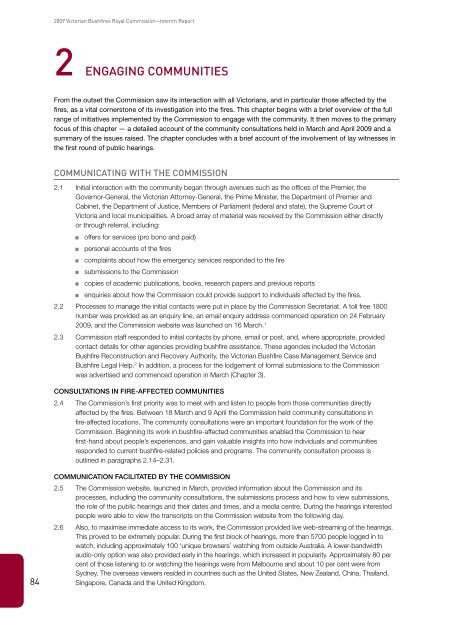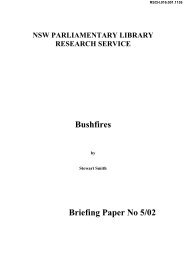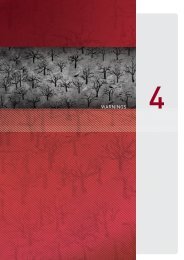engaging communities - 2009 Victorian Bushfires Royal Commission
engaging communities - 2009 Victorian Bushfires Royal Commission
engaging communities - 2009 Victorian Bushfires Royal Commission
Create successful ePaper yourself
Turn your PDF publications into a flip-book with our unique Google optimized e-Paper software.
<strong>2009</strong> <strong>Victorian</strong> <strong>Bushfires</strong> <strong>Royal</strong> <strong>Commission</strong>—Interim Report<br />
2 ENGAGING COMMUNITIES<br />
From the outset the <strong>Commission</strong> saw its interaction with all <strong>Victorian</strong>s, and in particular those affected by the<br />
fires, as a vital cornerstone of its investigation into the fires. This chapter begins with a brief overview of the full<br />
range of initiatives implemented by the <strong>Commission</strong> to engage with the community. It then moves to the primary<br />
focus of this chapter — a detailed account of the community consultations held in March and April <strong>2009</strong> and a<br />
summary of the issues raised. The chapter concludes with a brief account of the involvement of lay witnesses in<br />
the first round of public hearings.<br />
Communicating with the <strong>Commission</strong><br />
2.1<br />
2.2<br />
2.3<br />
Initial interaction with the community began through avenues such as the offices of the Premier, the<br />
Governor-General, the <strong>Victorian</strong> Attorney-General, the Prime Minister, the Department of Premier and<br />
Cabinet, the Department of Justice, Members of Parliament (federal and state), the Supreme Court of<br />
Victoria and local municipalities. A broad array of material was received by the <strong>Commission</strong> either directly<br />
or through referral, including:<br />
■■ offers for services (pro bono and paid)<br />
■■ personal accounts of the fires<br />
■■ complaints about how the emergency services responded to the fire<br />
■■ submissions to the <strong>Commission</strong><br />
■■ copies of academic publications, books, research papers and previous reports<br />
■■ enquiries about how the <strong>Commission</strong> could provide support to individuals affected by the fires.<br />
Processes to manage the initial contacts were put in place by the <strong>Commission</strong> Secretariat. A toll free 1800<br />
number was provided as an enquiry line, an email enquiry address commenced operation on 24 February<br />
<strong>2009</strong>, and the <strong>Commission</strong> website was launched on 16 March. 1<br />
<strong>Commission</strong> staff responded to initial contacts by phone, email or post, and, where appropriate, provided<br />
contact details for other agencies providing bushfire assistance. These agencies included the <strong>Victorian</strong><br />
Bushfire Reconstruction and Recovery Authority, the <strong>Victorian</strong> Bushfire Case Management Service and<br />
Bushfire Legal Help. 2 In addition, a process for the lodgement of formal submissions to the <strong>Commission</strong><br />
was advertised and commenced operation in March (Chapter 3).<br />
Consultations in Fire-affected Communities<br />
2.4 The <strong>Commission</strong>’s first priority was to meet with and listen to people from those <strong>communities</strong> directly<br />
affected by the fires. Between 18 March and 9 April the <strong>Commission</strong> held community consultations in<br />
fire-affected locations. The community consultations were an important foundation for the work of the<br />
<strong>Commission</strong>. Beginning its work in bushfire-affected <strong>communities</strong> enabled the <strong>Commission</strong> to hear<br />
first-hand about people’s experiences, and gain valuable insights into how individuals and <strong>communities</strong><br />
responded to current bushfire-related policies and programs. The community consultation process is<br />
outlined in paragraphs 2.14–2.31.<br />
84<br />
Communication Facilitated by the <strong>Commission</strong><br />
2.5 The <strong>Commission</strong> website, launched in March, provided information about the <strong>Commission</strong> and its<br />
processes, including the community consultations, the submissions process and how to view submissions,<br />
the role of the public hearings and their dates and times, and a media centre. During the hearings interested<br />
people were able to view the transcripts on the <strong>Commission</strong> website from the following day.<br />
2.6 Also, to maximise immediate access to its work, the <strong>Commission</strong> provided live web-streaming of the hearings.<br />
This proved to be extremely popular. During the first block of hearings, more than 5700 people logged in to<br />
watch, including approximately 100 ‘unique browsers’ watching from outside Australia. A lower-bandwidth<br />
audio-only option was also provided early in the hearings, which increased in popularity. Approximately 80 per<br />
cent of those listening to or watching the hearings were from Melbourne and about 10 per cent were from<br />
Sydney. The overseas viewers resided in countries such as the United States, New Zealand, China, Thailand,<br />
Singapore, Canada and the United Kingdom.
















